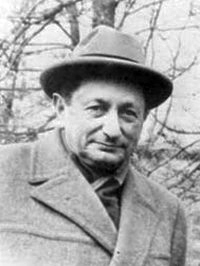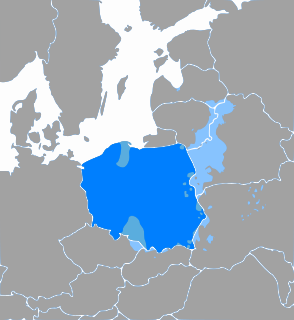This page is based on this
Wikipedia article Text is available under the
CC BY-SA 4.0 license; additional terms may apply.
Images, videos and audio are available under their respective licenses.

Kazimierz Kuratowski was a Polish mathematician and logician. He was one of the leading representatives of the Warsaw School of Mathematics.

Alfred Tarski, born Alfred Teitelbaum, was a Polish-American logician and mathematician of Polish-Jewish descent. Educated in Poland at the University of Warsaw, and a member of the Lwów–Warsaw school of logic and the Warsaw school of mathematics, he immigrated to the United States in 1939 where he became a naturalized citizen in 1945. Tarski taught and carried out research in mathematics at the University of California, Berkeley, from 1942 until his death in 1983.
In mathematical logic, interpretability is a relation between formal theories that expresses the possibility of interpreting or translating one into the other.
Warsaw School of Mathematics is the name given to a group of mathematicians who worked at Warsaw, Poland, in the two decades between the World Wars, especially in the fields of logic, set theory, point-set topology and real analysis. They published in the journal Fundamenta Mathematicae, founded in 1920—one of the world's first specialist pure-mathematics journals. It was in this journal, in 1933, that Alfred Tarski—whose illustrious career would a few years later take him to the University of California, Berkeley—published his celebrated theorem on the undefinability of the notion of truth.
In set theory, a branch of mathematical logic, an inner model for a theory T is a substructure of a model M of a set theory that is both a model for T and contains all the ordinals of M.

The ideas of the Age of Enlightenment in Poland were developed later than in Western Europe, as the Polish bourgeoisie was weaker, and szlachta (nobility) culture (Sarmatism) together with the Polish-Lithuanian Commonwealth political system were in deep crisis. The period of Polish Enlightenment began in the 1730s–40s, peaked in the reign of Poland's last king, Stanisław August Poniatowski, went into decline with the Third Partition of Poland (1795) – a national tragedy inspiring a short period of sentimental writing – and ended in 1822, replaced by Romanticism.

The Neoclassical architecture in Poland was centered in Warsaw under the reign of Stanisław August Poniatowski, while the modern concept of a single capital city was to some extent inapplicable in the decentralized Polish–Lithuanian Commonwealth. Classicism came to Poland in the 18th century as the result of French infiltrations into the Polish millieu. The best-known architects and artists who worked in Poland were Dominik Merlini, Jan Chrystian Kamsetzer, Szymon Bogumił Zug, Stanisław Zawadzki, Efraim Szreger, Antonio Corazzi, Jakub Kubicki, Christian Piotr Aigner, Wawrzyniec Gucewicz, Bonifacy Witkowski and Danish Bertel Thorvaldsen.
Effective descriptive set theory is the branch of descriptive set theory dealing with sets of reals having lightface definitions; that is, definitions that do not require an arbitrary real parameter. Thus effective descriptive set theory combines descriptive set theory with recursion theory.

Helena Rasiowa was a Polish mathematician. She worked in the foundations of mathematics and algebraic logic.

Antoni Stanisław Brodowski was a Polish painter in the Classical style.
Andrzej Ehrenfeucht is a Polish American mathematician and computer scientist. He formulated the Ehrenfeucht–Fraïssé game, using the back-and-forth method given by Roland Fraïssé in his thesis. The Ehrenfeucht–Mycielski sequence is also named after him.
The Vaught conjecture is a conjecture in the mathematical field of model theory originally proposed by Robert Lawson Vaught in 1961. It states that the number of countable models of a first-order complete theory in a countable language is finite or ℵ0 or 2ℵ0. Morley showed that number of countable models is finite or ℵ0 or ℵ1 or 2ℵ0, which solves the conjecture except for the case of ℵ1 models when the continuum hypothesis fails. For this remaining case, Robin Knight has announced a counterexample to the Vaught conjecture and the topological Vaught conjecture. As of 2016 the counterexample has not been verified.

Zgromadzenie Przyjaciół Konstytucji Rządowej was the first modern Polish political party, formed in May 1791, shortly after the adoption of the Constitution of May 3, 1791, by the efforts of the Patriotic Party. The purpose of the Friends of the Constitution was to defend the reformed political system and to introduce further reforms.
In mathematical set theory, a permutation model is a model of set theory with atoms (ZFA) constructed using a group of permutations of the atoms. A symmetric model is similar except that it is a model of ZF and is constructed using a group of permutations of a forcing poset. One application is to show the independence of the axiom of choice from the other axioms of ZFA or ZF.
Permutation models were introduced by Fraenkel (1922) and developed further by Mostowski (1938).
Symmetric models were introduced by Paul Cohen.









